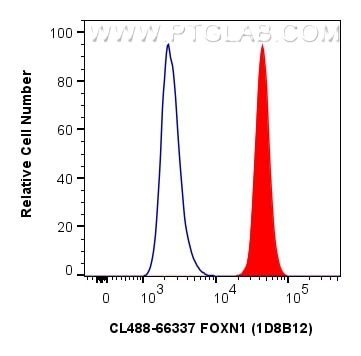FOXN1 Monoklonaler Antikörper
FOXN1 Monoklonal Antikörper für FC (Intra)
Wirt / Isotyp
Maus / IgG1
Getestete Reaktivität
human
Anwendung
FC (Intra)
Konjugation
CoraLite® Plus 488 Fluorescent Dye
CloneNo.
1D8B12
Kat-Nr. : CL488-66337
Synonyme
Galerie der Validierungsdaten
Geprüfte Anwendungen
| Erfolgreiche Detektion in FC | A549-Zellen |
Empfohlene Verdünnung
| Anwendung | Verdünnung |
|---|---|
| Durchflusszytometrie (FC) | FC : 0.80 ug per 10^6 cells in a 100 µl suspension |
| It is recommended that this reagent should be titrated in each testing system to obtain optimal results. | |
| Sample-dependent, check data in validation data gallery | |
Produktinformation
CL488-66337 bindet in FC (Intra) FOXN1 und zeigt Reaktivität mit human
| Getestete Reaktivität | human |
| Wirt / Isotyp | Maus / IgG1 |
| Klonalität | Monoklonal |
| Typ | Antikörper |
| Immunogen | FOXN1 fusion protein Ag18207 |
| Vollständiger Name | forkhead box N1 |
| Berechnetes Molekulargewicht | 648 aa, 69 kDa |
| Beobachtetes Molekulargewicht | 60 kDa |
| GenBank-Zugangsnummer | BC146539 |
| Gene symbol | FOXN1 |
| Gene ID (NCBI) | 8456 |
| Konjugation | CoraLite® Plus 488 Fluorescent Dye |
| Excitation/Emission maxima wavelengths | 493 nm / 522 nm |
| Form | Liquid |
| Reinigungsmethode | Protein-G-Reinigung |
| Lagerungspuffer | BS mit 50% Glyzerin, 0,05% Proclin300, 0,5% BSA, pH 7,3. |
| Lagerungsbedingungen | Bei -20°C lagern. Vor Licht schützen. Nach dem Versand ein Jahr stabil. Aliquotieren ist bei -20oC Lagerung nicht notwendig. 20ul Größen enthalten 0,1% BSA. |
Hintergrundinformationen
FOXN1, also named as Forkhead box protein N1, is a 648 amino acid protein, which contains 1 fork-head DNA-binding domain and localizes in the nucleus. FOXN1 as transcriptional regulator regulates the development, differentiation, and function of thymic epithelial cells (TECs) both in the prenatal and postnatal thymus. FOXN1 acts as a master regulator of the TECs lineage development and is required from the onset of differentiation in progenitor TECs in the developing fetus to the final differentiation steps through which TECs mature to acquire their full functionality.


